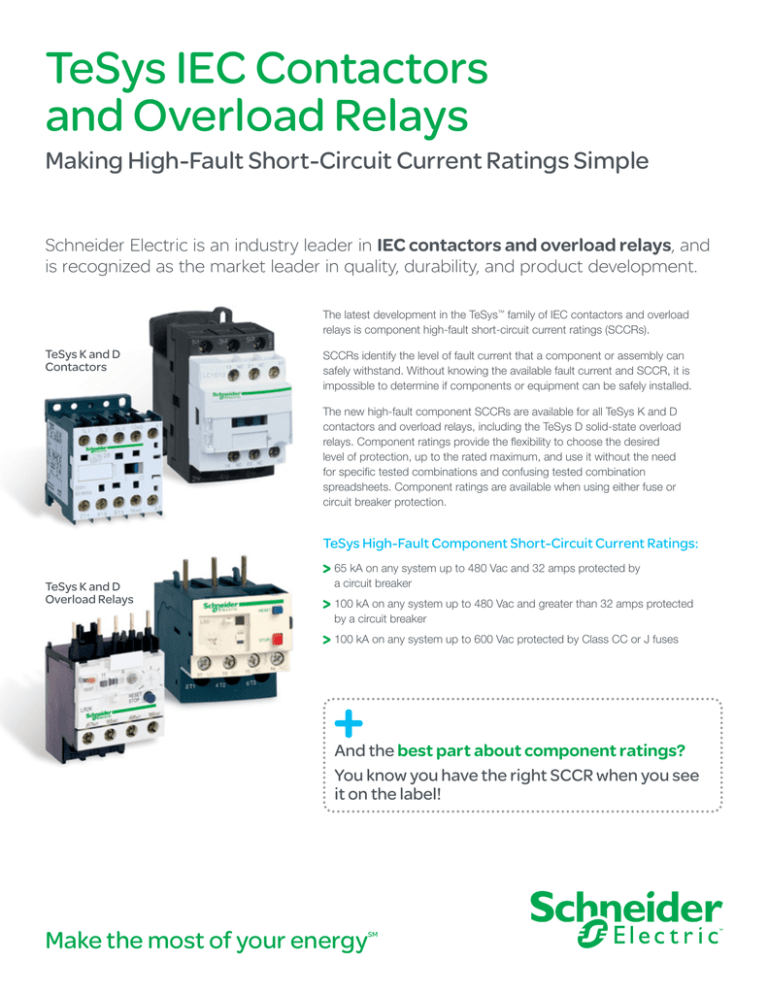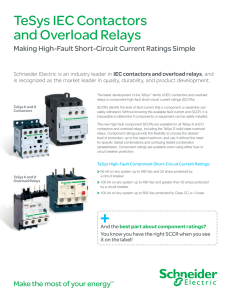
TeSys IEC Contactors
and Overload Relays
Making High-Fault Short-Circuit Current Ratings Simple
Schneider Electric is an industry leader in IEC contactors and overload relays, and
is recognized as the market leader in quality, durability, and product development.
The latest development in the TeSys™ family of IEC contactors and overload
relays is component high-fault short-circuit current ratings (SCCRs).
TeSys K and D
Contactors
SCCRs identify the level of fault current that a component or assembly can
safely withstand. Without knowing the available fault current and SCCR, it is
impossible to determine if components or equipment can be safely installed.
The new high-fault component SCCRs are available for all TeSys K and D
contactors and overload relays, including the TeSys D solid-state overload
relays. Component ratings provide the flexibility to choose the desired
level of protection, up to the rated maximum, and use it without the need
for specific tested combinations and confusing tested combination
spreadsheets. Component ratings are available when using either fuse or
circuit breaker protection.
TeSys High-Fault Component Short-Circuit Current Ratings:
TeSys K and D
Overload Relays
65 kA on any system up to 480 Vac and 32 amps protected by
a circuit breaker
100 kA on any system up to 480 Vac and greater than 32 amps protected
by a circuit breaker
100 kA on any system up to 600 Vac protected by Class CC or J fuses
And the best part about component ratings?
You know you have the right SCCR when you see
it on the label!
Make the most of your energy
SM
TeSys D Overload Relays
Class 10
Class 10 with
Class 20 with
without
Single-Phase
Single-Phase
Single-Phase
Sensitivity
Sensitivity
Sensitivity
Maximum Component SCCR (kA)[1]
Class 20
without
Circuit Breakers Fuses
Single-Phase @ 480 V[2]
@ 600 V[3]
Sensitivity
Max. SCCR (kA) Max. SCCR (kA)
0.10 – 0.16
LRD01
LR3D01
—
—
65
100
0.16 – 0.25
LRD02
LR3D02
—
—
65
100
0.25 – 0.40
LRD03
LR3D03
—
—
65
100
0.40 – 0.63
LRD04
LR3D04
—
—
65
100
0.63 – 1
LRD05
LR3D05
—
—
65
100
Current
Setting
Range (A)
1 – 1.6
For Direct
Mounting to
LC1…
LRD06
LR3D06
—
—
65
100
1.6 – 2.5
D09 – D32
LRD07
LR3D07
—
—
65
100
2.5 – 4
LRD08
LR3D08
LRD1508
LR3D1508A
65
100
4–6
LRD10
LR3D10
LRD1510
LR3D1510A
65
100
5.5 – 8
LRD12
LR3D12
LRD1512
LR3D1512A
65
100
7 – 10
LRD14
LR3D14
LRD1514
LR3D1514A
65
100
9 – 13
D12 – D32
LRD16
LR3D16
LRD1516
LR3D1516A
65
100
12 – 18
D18 – D32
LRD21
LR3D21
LRD1521
LR3D1521A
65
100
16 – 24
LRD22
LR3D22
—
—
65
100
17 – 25
—
—
LRD1522
LR3D1522A
65
100
LRD32
LR3D32
—
—
65
100
—
—
LRD1530
LR3D1530A
65
100
—
—
LRD1532
LR3D1532A
65
100
LRD35
LR3D35
—
—
65
100
9 – 13
LRD313
LR3D313
LRD313L
—
100
100
12 – 18
LRD318
LR3D318
LRD318L
—
100
100
16 – 25
LRD325
LR3D325
LRD325L
—
100
100
LRD332
LR3D332
LRD332L
—
100
100
LRD340
LR3D340
LRD340L
—
100
100
37 – 50
LRD350
LR3D350
LRD350L
—
100
100
48 – 65
D50A – D65A[4] LRD365
LR3D365
LRD365L
—
100
100
LRD3322
LR3D3322
LR2D3522
LR3D3522
100
100
LRD3353
LR3D3353
LR2D3553
LR3D3553
100
100
LRD3355
LR3D3355
LR2D3555
LR3D3555
100
100
LRD3357
LR3D3357
LR2D3557
LR3D3557
100
100
LRD3359
LR3D3359
LR2D3559
LR3D3559
100
100
LRD3361
LR3D3361
LR2D3561
LR3D3561
100
100
LRD3363
LR3D3363
LR2D3563
LR3D3563
100
100
LRD3365
—
—
—
100
100
LRD4365
—
—
—
100
100
LRD4367
—
—
—
100
100
23 – 32
D25 – D32
23 – 28
25 – 32
30 – 38
23 – 32
D32
D40A – D65A[4]
30 – 40
17 – 25
23 – 32
D40 – D80[5]
30 – 40
37 – 50
48 – 65
55 – 70
63 – 80
80 – 104
80 – 104
95 – 120
D50 – D80[5]
D65 – D80[5]
D80
D115 – D150
Ratings apply to circuits with voltages no greater than those listed and are subject to maximum breaker and fuse ampacities. See data
bulletin 8536DB0901 for ampacity limitations.
[2]
When protected by any circuit breaker, including thermal-magnetic and magnetic-only.
[3]
When protected by any Class J or CC time-delay fuse (Class CC applicable up to 30 A only).
[4]
Overload relays with Everlink™ termination — direct mount to D40A to D65A only.
[5]
Direct mount to old D2 style D40 to D65 (no Everlink terminations) and to D80 only.
[1]
Note: This table lists the maximum SCCR of the component when protected by any circuit breaker or fuse. If the maximum component SCCR
is 100 kA and a 25 kA rated circuit breaker is used, then the system will be 25 kA as the circuit breaker becomes the weakest link.
3
TeSys™ D-Line Contactors and Starters
LR2 and LR3D 3-pole Bimetallic Overload Relays
LR2 and LR3D 3-pole Bimetallic Overload Relays
Description
D-Line 3-pole thermal overload relays are designed to protect ac circuits and motors against overloads, phase failure, long starting times and prolonged
stalling of the motor.
LRD3322 to 4369, LR2D
LRD01 to 35
1
1
6
41
46
3.5
2
0 1
5
STOP
3
50
3
5
37
5
A
RESET
2
4
3
R
A E
S
E
T
M
TEST
4
6
4
NO
7
98
NC
97
95
96
1 Adjustment dial Ir
2 Test button
Operation of the Test button allows:
- checking of control circuit wiring,
- simulation of relay tripping (actuates both the N.O. and N.C. contacts).
3 Stop button. Actuates the N.C. contact; does not affect the N.O. contact.
4 Reset button
5 Trip indicator
6 Setting locked by sealing the cover.
7 Selector for manual or automatic reset. Relays LRD01 to LRD35 are supplied with the selector in the manual position, protected by a cover. Deliberate
action is required to move it to the automatic position.
Environment
IEC 60947-1, IEC 60947-4-1, NF C 63-650, VDE 0660,
BS 4941
Conforming to standards
Product certifications
CSA, UL, Sichere Trennung, PTB except LAD4: UL, CSA.
Degree of protection
Conforming to VDE 0106
Protective treatment
Conforming to IEC 60068
Ambient air temperature
around the device
Protection against direct finger contact IP 2X
“TH”
Storage
°C
- 60 to + 70 (- 140 to + 158 °F)
Normal operation, without derating (IEC 60947-4-1)
°C
- 20 to + 60 (- 68 to + 140 °F)
Minimum and maximum operating temperatures (with derating)
°C
- 40 to + 70 (- 104 to + 158 °F)
Operating positions without derating
In relation to normal, vertical mounting plane
Any position
Shock resistance
Permissible acceleration conforming to IEC 60068-2-7
15 gn - 11 ms
Vibration resistance
Permissible acceleration conforming to IEC 60068-2-6
Dielectric strength at 50 Hz
Conforming to IEC 60255-5
kV
6
Impulse withstand voltage
Conforming to IEC 60801-5
kV
6
6 gn
Auxiliary Contact Characteristics
Conventional rated thermal current
A
5 Amps AC; 1 Amp DC
V
24
48
110
220
380
600
VA
100
200
400
600
600
600
V
24
48
110
220
440
–
W
100
100
50
45
25
–
By gG, BS or Class CC fuse. Max. rating or by GB2 circuit-breaker
A
5 maximum
Flexible cable with cable end
One or two conductors
AWG (mm2)
18 - 14 (1 - 2.5)
Solid cable without cable end
One or two conductors
AWG (mm2)
18 - 14 (1 - 2.5)
Flexible cable without cable end
One or two conductors
AWG (mm2)
18 - 14 (1 - 2.5)
Solid cable without cable end
One or two conductors
AWG (mm2)
18 - 14 (1 - 2.5)
lb-in (N.m)
15 (1.7)
ac supply
Maximum consumption
of operating coils
of controlled contactors
(Occasional operating
cycles of contact 95-96)
Short-circuit protection k
dc supply
Connection to screw clamp terminals
Min - max c.s.a.
Tightening torque
k
Select short circuit protection to meet the National Electrical Code or other local codes and standards.
Catalog Numbers: pages 134, 135
Dimensions: pages 138 - 140
130
© 2001-2004 Schneider Electric All Rights Reserved
01/04
TeSys™ D-Line Contactors and Starters
LR2 and LR3D 3-pole Bimetallic Overload Relays
Electrical Characteristics of Power Circuit
LRD
01 to 16
Relay type
Tripping class
Rated insulation voltage (Ui)
LR2
D15••
LR3
D01 to D16
To UL 508, IEC 60947-4-1
V
LR2
D25••
LRD
3322 to
33696
LR3
D21 to D35
10
Conforming to
IEC 60947-4-1
LRD
21 to 35
20
690
10
LRD
4365 to 4369
20
10
LR3
D3322 to
D33696
20
10
690
1000
600
600 except
LRD4369
V
kV
6
6
6
6
Frequency limits
Of the operational current
Hz
0 to 400
0 to 400
0 to 400
0 to 400
Setting range
Depending on model
A
0.1 to 13
12 to 38
17 to 104
80 to 140
Flexible cable without cable end
One conductor
AWG (mm2)
14 - 8 (1.5 - 10)
14 - 8 (1.5 - 10)
10 - 2 (4 35)
10 - 1 (4 - 50)
Flexible cable with cable end
One conductor
AWG (mm2)
16 - 12 (1 - 4)
16 - 10 (1 - 6) except LRD21:
16 - 12 (1 - 4)
10 - 2 (4 35)
10 - 2 (4 - 35)
AWG (mm2)
16 - 10 (1 - 6)
14 - 8 (1.5 - 10) except LRD21:
16 - 10 (1 - 6)
12 - 2 (4 35)
10 - 1 (4 - 50)
lb-In (N.m)
15.0 (1.7)
22.1 (2.5)
100 lb-in
100 lb-in
Connection to screw clamp terminals
Solid cable without cable end
600
1000
Conforming to UL, CSA
Rated impulse withstand voltage
(Uimp)
600
LR2
D35••
Min - max c.s.a.
One conductor
Tightening torque
Connection to spring terminals
16.4 (1.85)
Min - max c.s.a.
Flexible cable without cable end
One conductor
AWG (mm2)
14 - 12 (1.5 - 4) –
14 - 12 (1.5 - 4) –
–
–
–
Solid cable without cable end
One conductor
AWG (mm2)
14 - 12 (1.5 - 4) –
14 - 12 (1.5 - 4) –
–
–
–
°C
°F
- 20 to + 60
- 68 to + 140
- 30 to + 60
- 86 to + 140
- 30 to + 60
- 86 to + 140
Operating Characteristics
Temperature compensation
Tripping threshold
Conforming to IEC 60947-4-1
Sensitivity to phase failure
Conforming to IEC 60947-4-1
A
- 20 to + 60
- 68 to + 140
1.14 ± 0.06 In
Tripping current 30% of In on one phase, the others at In
Tripping curves
Average operating time
related to multiples of the
current setting
Class 10
Hours
Minutes
Seconds
Class 20
Hours
2
1
40
20
20
10
Minutes
4
2
2
1
40
1
40
20
20
10
10
Seconds
1
2
3
1
0.8
0.8 1
2
4
6
10
2
1
0.8
17 20
0.8 1
x times current setting (Ir)
01/04
1
2
3
4
2
Catalog Numbers: pages 134, 135
10
4
4
1
2
3
2
1
40
2
4
6
10
17 20
x times current setting (Ir)
Balanced operation, 3-phase, from cold state.
Balanced operation, 2-phase, from cold state.
Balanced operation, 3-phase, after a long period at the set current (hot state).
Dimensions: pages 138 - 140
© 2001-2004 Schneider Electric All Rights Reserved
131




